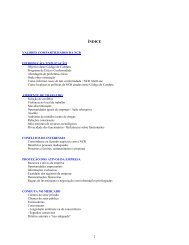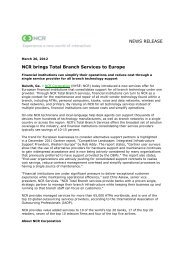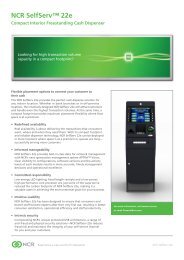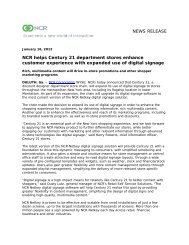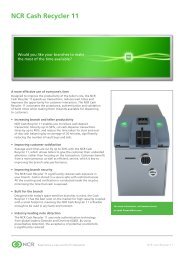Financial Inclusion White Paper - NCR
Financial Inclusion White Paper - NCR
Financial Inclusion White Paper - NCR
Create successful ePaper yourself
Turn your PDF publications into a flip-book with our unique Google optimized e-Paper software.
5.1.3 Kisan Credit Cards (KCC)<br />
The Kisan Credit Card (KCC) scheme is a form of cash credit facility for farmers<br />
and was introduced in 1998-99 by the Government of India, the National Bank for<br />
Agriculture and Rural Development (NABARD) and the RBI.<br />
A pioneering credit delivery mechanism, KCC is intended to provide adequate and<br />
timely support from the banking system to farmers for their cultivation needs,<br />
including the purchase of seeds, fertilizers, pesticides and livestock in a flexible<br />
and cost-effective manner.<br />
According to the Report on Trends and Progress of Banking in India for the year<br />
2006-07 released by the RBI, a total of 66.55 million Kisan Credit Cards had been<br />
issued by the end of 2007.<br />
Major Challenge<br />
Adressed<br />
Credit facility:<br />
Spontaneous credit<br />
5.1.4 Remittance<br />
Limitations Solution Roadmap<br />
Absence of track record,<br />
cumbersome process<br />
Unavailability for poor<br />
farmers: Available exclusively<br />
for privileged class of farmers<br />
Ignorance: Facility virtually<br />
ignores landless and marginal<br />
farmers as well as noncultivating<br />
households<br />
Self-service kiosks, data<br />
network and SHGs<br />
Innovative products, selfservice<br />
solutions, shared<br />
service outlets, BC and<br />
flexible credit policy<br />
Indian agriculture is characterized by seasonal rain (monsoon), seasonal crop<br />
patterns and labour-intensive, non-mechanised cultivation techniques. Wool work,<br />
agro-based and several small scale industries in rural and semi-urban India are<br />
mostly seasonal, dependent on crops or festive seasons (such as the production<br />
of firecrackers used in ‘Diwali’ festival in India).<br />
As a result there is a large migrant population moving between rural and urban<br />
centers in search of (mostly unskilled) jobs. Earnings from this section of the<br />
population (put at 30 percent or 330 million people by the latest Indian census)<br />
need to be regularly remitted to their families back in their villages.<br />
Today, India Post’s ‘money order’ service is the biggest remittance platform,<br />
thanks to its vast network of 155,000 branches. As well as being the biggest, it is<br />
widely considered to be the costliest, charging five percent of the funds<br />
transferred. In 2005-06, India Post handled 96 million money orders worth $1.8<br />
billion.<br />
22




